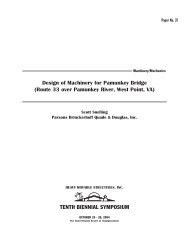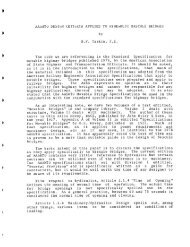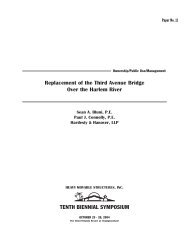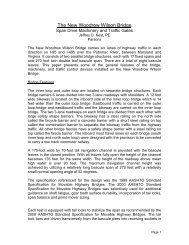Balancing of Movable Bridges by the Strain Gauge Technique
Balancing of Movable Bridges by the Strain Gauge Technique
Balancing of Movable Bridges by the Strain Gauge Technique
You also want an ePaper? Increase the reach of your titles
YUMPU automatically turns print PDFs into web optimized ePapers that Google loves.
IntroductionSeveral moveable bridges were built in <strong>the</strong> United States during <strong>the</strong>mid and early 20th century. To prolong <strong>the</strong> life and reduce costlyequipment replacement and refurbishing, <strong>the</strong> bridge should bemaintained in a good operating balance state.The two major bridge types considered here are vertical liftbridges and bascule span bridges. Vertical lift, much like anelevator, are raised <strong>by</strong> cables at each <strong>of</strong> <strong>the</strong> four corners <strong>of</strong> <strong>the</strong>span. The cables are suspended from pulleys supported <strong>by</strong> towers.The weight <strong>of</strong> <strong>the</strong> span are balanced <strong>by</strong> a counterweight attached to<strong>the</strong> cables on <strong>the</strong> opposite side <strong>of</strong> <strong>the</strong> pulleys.There are two major types <strong>of</strong> bascule bridges. These are trunnionand roller types. A trunnion type consists <strong>of</strong> a deck supportingleaf and a counterweight that pivots about a fixed trunnionbearing. The roller type bascule bridge consists <strong>of</strong> a leaf andcounterweight that pivot about <strong>the</strong> axis <strong>of</strong> a large roller. Rollerbridges rotate and move horizontally during its operation.Both bridge types can develop excessive imbalances caused <strong>by</strong> deckrehabilitation, addition <strong>of</strong> utilities, dirt accumulation, paint,and numerous o<strong>the</strong>r reasons. These imbalances can increaseoperating power requirements and machine wear, and in extreme casescause equipment failure and create potential hazardous conditions.Several methods exist to balance a bascule bridge, but most providean incomplete picture <strong>of</strong> <strong>the</strong> full balance state <strong>of</strong> <strong>the</strong> bridge.This paper will present a method <strong>of</strong> determining <strong>the</strong> balance state<strong>of</strong> a bascule bridge using strain gages on <strong>the</strong> final pinion shafts.The gages are used to measure operating torque during <strong>the</strong> raisingand lowering <strong>of</strong> <strong>the</strong> span. For vertical lift bridges <strong>the</strong> data canbe used to determine <strong>the</strong> present balance state and trunnionfriction. For bascule bridges <strong>the</strong> resulting data can be used to
















